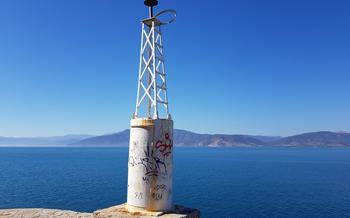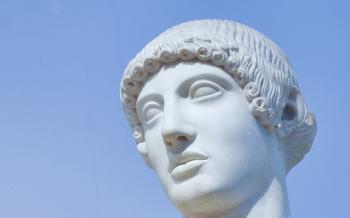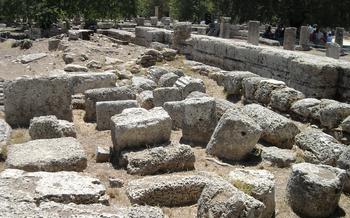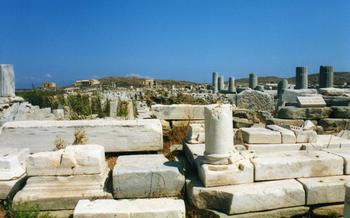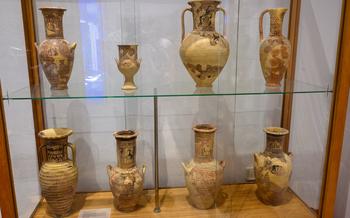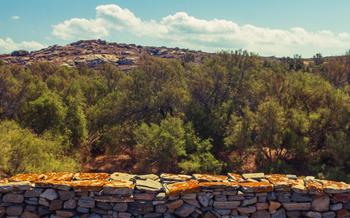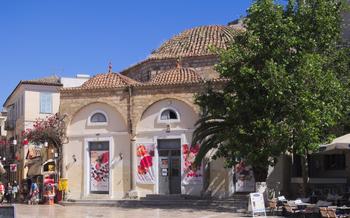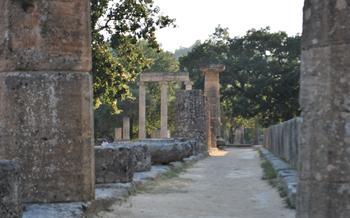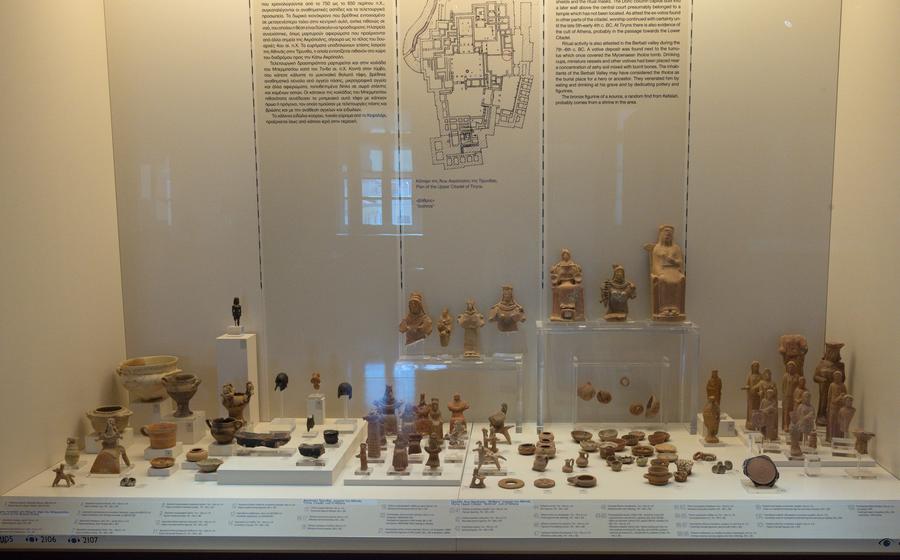
Temple of Apollo at Ancient Corinth
- Journey through Time: Temple of Apollo at Ancient Corinth
- Historical Significance: A Legacy of Ancient Greece
- Architectural Marvel: A Masterpiece of Antiquity
- Excavations and Discoveries: Unraveling the Past
- Temple Layout and Design: Exploring the Sacred Space
- Mythical Tales and Legends: Apollo's Presence
- Religious Rituals and Practices: Honoring the God
- Panoramic Views: Awe-Inspiring Landscapes
- Interactive Displays and Exhibitions: Bringing History to Life
- Transportation and Accessibility: Getting There
- Admission Fees and Hours of Operation: Practical Information
- Photography and Videography: Capturing the Essence
- Nearby Attractions: Exploring Ancient Corinth
- Local Cuisine and Dining Options: A Taste of Corinth
- Insider Tip: Unforgettable Sunset Views
Journey through Time: Temple of Apollo at Ancient Corinth
In the heart of the ancient city of Corinth, nestled amidst rolling hills and overlooking the shimmering Gulf of Corinth, stands the Temple of Apollo, a testament to the enduring legacy of ancient Greece. Constructed in the 6th century BC, this Doric temple was dedicated to Apollo, the revered god of music, poetry, prophecy, and healing. The temple served as a sacred site for religious rituals, ceremonies, and consultations with the oracle, inviting pilgrims and worshippers from across the Hellenic world. As you explore the ruins of this once-magnificent structure, you'll be transported back in time, witnessing the grandeur and spirituality that permeated ancient Greek civilization.
Historical Significance: A Legacy of Ancient Greece
The Temple of Apollo held immense significance in the ancient world, serving as a testament to the enduring legacy of Greek mythology, religion, and politics. Apollo, the radiant god of music, healing, and prophecy, was deeply revered in ancient Greece, and his temple at Corinth stood as a symbol of his divine presence.
The city of Corinth itself played a pivotal role in the history of ancient Greece. Strategically located on the narrow isthmus connecting the Peloponnese to the mainland, Corinth was a thriving center of trade and commerce. Its strategic position allowed it to control both the land and sea routes between the Aegean and Ionian Seas, making it a wealthy and influential city-state.
Corinth's membership in the prestigious Panhellenic League further solidified its importance in the ancient Greek world. The Panhellenic League, a confederation of Greek city-states, was established to promote cooperation and unity among the Greeks. Corinth's participation in this league demonstrated its status as a prominent and respected member of the Greek world.
Throughout history, the Temple of Apollo witnessed many significant events and was associated with influential figures. The renowned Greek orator, Demosthenes, is said to have visited the temple to consult the oracle of Apollo, seeking divine guidance and wisdom. The temple also played a role in the Peloponnesian War, a devastating conflict between Athens and Sparta.
Architectural Marvel: A Masterpiece of Antiquity
The Temple of Apollo stands as a testament to the architectural prowess of the ancient Greeks. Constructed in the 6th century BC, the temple exhibits a harmonious blend of Doric and Ionic architectural styles. Its sturdy foundation and walls are composed of local limestone, quarried from the surrounding hills. The temple's most striking feature is its row of Doric columns, each standing over 7 meters tall and fluted with 20 shallow grooves. These columns support a massive entablature, which features a frieze adorned with intricate carvings depicting mythological scenes.
The temple's pediments, located at the east and west ends of the roof, showcase exquisite sculptures crafted from Parian marble. These pediments originally depicted scenes from Greek mythology, but unfortunately, only fragments of these sculptures have survived to the present day. Despite the ravages of time, the Temple of Apollo remains an architectural masterpiece, showcasing the ingenuity and artistry of the ancient Greeks.
Compared to other significant ancient temples in Greece, such as the Parthenon in Athens or the Temple of Zeus at Olympia, the Temple of Apollo in Ancient Corinth may not be as grand in size or ornamentation. However, its unique features and historical significance make it a must-visit destination for anyone interested in ancient Greek architecture and history.
Excavations and Discoveries: Unraveling the Past
Archaeological excavations at the Temple of Apollo in Ancient Corinth have shed light on the rich history and cultural significance of this sacred site. Conducted over several decades, these excavations have unearthed a treasure trove of artifacts and inscriptions, providing valuable insights into the daily life and culture of the ancient Corinthians. Among the most notable discoveries are exquisite sculptures, including fragments of a colossal statue of Apollo, as well as inscriptions that reveal the names of priests, priestesses, and other officials associated with the temple. These findings have contributed significantly to our understanding of the religious practices and rituals that took place within the temple walls. Ongoing research and preservation efforts continue to uncover new details about the temple's history, ensuring that its legacy remains alive for generations to come.
Temple Layout and Design: Exploring the Sacred Space
The Temple of Apollo at Ancient Corinth stands as a testament to the architectural prowess of the ancient Greeks. Measuring approximately 50 meters in length and 20 meters in width, the temple's dimensions exude a sense of grandeur and significance. Its orientation aligns precisely with the cardinal directions, demonstrating the meticulous planning and astronomical knowledge of its builders.
Entering the temple, visitors encounter the pronaos, a columned porch leading to the cella, the temple's inner sanctum. The cella housed the cult statue of Apollo, a revered object of worship for the ancient Corinthians. The statue, sculpted from precious materials such as gold and ivory, was believed to possess divine power and was adorned with offerings and gifts from devout worshippers.
Surrounding the temple, a series of peripteral columns creates a majestic colonnade, supporting the temple's entablature and pediments. These columns, each standing over 6 meters tall, are crafted from limestone and exhibit the characteristic Doric style, with their simple, fluted shafts and capitals devoid of ornamentation.
The pediments, triangular gables positioned at the temple's east and west ends, once displayed intricate sculptures depicting mythological scenes. Although these sculptures have been lost to the passage of time, their remnants hint at the artistic splendor that adorned the temple in its heyday.
Evidence suggests that the temple underwent several modifications and repairs throughout its history. The original wooden roof was replaced with a marble one, and the cella was expanded to accommodate the growing number of worshippers. These modifications reflect the temple's enduring significance as a religious and civic center in ancient Corinth.
Mythical Tales and Legends: Apollo's Presence
The Temple of Apollo at Ancient Corinth is steeped in a rich tapestry of myths and legends that have been passed down through generations. Apollo, the Greek god of music, prophecy, healing, and the sun, played a significant role in the founding and history of Corinth. According to Greek mythology, Apollo was born on the nearby island of Delos, and his twin sister, Artemis, was born in Ortygia, a sacred grove near Corinth.
Legends surround the founding of Corinth and its relationship to Apollo. One tale tells of the hero Bellerophon, who was sent by the king of Corinth to slay the monstrous Chimera. Bellerophon, aided by his winged horse Pegasus, successfully defeated the Chimera and dedicated a portion of his spoils to Apollo, establishing the god's presence in Corinth.
Another legend speaks of the arrival of the Bacchiadae, a powerful clan from Corinth, at Delphi, where they consulted the oracle of Apollo. The oracle instructed them to found a new city at the site where a particular eagle would drop a clod of earth. The eagle eventually dropped the clod on the Acrocorinth, a hill overlooking the future site of Corinth, leading to the city's establishment under Apollo's guidance.
Religious Rituals and Practices: Honoring the God
The Temple of Apollo was not merely a monument but a sacred space where ancient Corinthians paid homage to their revered god. Elaborate ceremonies and festivals were held to honor Apollo, drawing devotees from far and wide. During these festivals, the temple would come alive with vibrant processions, music, and prayers.
Offerings to Apollo were a central part of religious practices. Devotees brought gifts and sacrifices to the temple, seeking Apollo's favor and blessings. These offerings could range from simple agricultural produce to valuable treasures, reflecting the giver's devotion.
Priests and priestesses played a crucial role in conducting religious rituals at the temple. They were responsible for preparing the offerings, reciting prayers, and performing sacred rites. The oracle at the temple was also highly revered, and people sought prophecies and guidance from Apollo through the oracle's utterances.
Panoramic Views: Awe-Inspiring Landscapes
Perched atop a hill overlooking the ancient city, the Temple of Apollo offers visitors breathtaking panoramic views of the surrounding landscapes. To the north, the majestic Acrocorinth, a towering natural fortress, stands sentinel over the region. To the west, the shimmering waters of the Corinthian Gulf stretch out towards the horizon, dotted with verdant islands and distant mountain ranges. The temple's strategic location allowed the ancient Corinthians to control vital land and sea trade routes, contributing to their prosperity and influence. Whether marveling at the rugged beauty of the mountains or gazing out across the tranquil sea, visitors can't help but be captivated by the awe-inspiring vistas that unfold before them. The temple's hilltop perch provides a unique vantage point from which to appreciate the natural grandeur of the Peloponnese, making it a must-see for anyone exploring the region.
Interactive Displays and Exhibitions: Bringing History to Life
Enhancing the visitor experience at the Temple of Apollo, an on-site museum showcases a captivating array of artifacts and discoveries unearthed during archaeological excavations. Interactive displays and multimedia presentations bring the history and significance of the temple to life, providing a deeper understanding of its role in ancient Greek society. Educational programs and guided tours led by knowledgeable experts offer visitors an immersive journey through time, allowing them to connect with the past and gain insights into the daily lives and beliefs of the ancient Corinthians. Hands-on experiences and interactive learning activities further engage visitors, particularly younger audiences, fostering a deeper appreciation for the rich cultural heritage of Greece.
Transportation and Accessibility: Getting There
The Temple of Apollo is situated within the archaeological site of Ancient Corinth, which is conveniently located just a short distance from the modern town of Corinth. Visitors can easily reach the site by car, utilizing the well-maintained roads that connect Corinth to other major cities in Greece. Ample parking facilities are available within the archaeological park, ensuring a hassle-free visit.
For those relying on public transportation, regular bus services operate from Corinth to the archaeological site, providing a convenient and affordable option. Additionally, organized tours are readily available, offering a comprehensive and guided experience of the ancient city, including the Temple of Apollo.
To make the most of your visit, plan your trip during the shoulder seasons (spring and autumn) when the weather is pleasant, and crowds are typically smaller. This allows you to explore the site at a leisurely pace, immersing yourself in its rich history and captivating atmosphere.
Admission Fees and Hours of Operation: Practical Information
To fully explore the wonders of the Temple of Apollo and the surrounding archaeological site of Ancient Corinth, it is essential to plan your visit with practical information in mind. Admission fees are typically charged for entry into the site, and it is advisable to check official sources or consult with local tourism offices for the most up-to-date pricing. Various ticketing options may be available, including reduced rates for students, seniors, and families, as well as combined tickets that grant access to multiple attractions within the archaeological park.
The hours of operation for the site vary depending on the season and may be subject to change. Generally, the site is open to visitors during daylight hours, with extended hours during the peak tourist season. It is recommended to check the official website or contact local tourism authorities for specific opening and closing times to avoid any inconvenience.
For a more fulfilling and informative experience, guided tours are available, led by knowledgeable experts who can provide insights into the history, architecture, and significance of the Temple of Apollo and other landmarks within the archaeological park. These tours are typically offered in multiple languages and can be arranged through local tour operators or directly through the archaeological site's visitor center.
To enhance your visit, consider arriving early in the morning or late in the afternoon to avoid the crowds and enjoy a more peaceful exploration of the site. This will allow you to fully appreciate the grandeur of the Temple of Apollo and capture stunning photographs without distractions.
Photography and Videography: Capturing the Essence
Guidelines and Restrictions:
- Respect the sanctity of the archaeological site and avoid disturbing ongoing excavations.
- Photography for personal use is generally permitted, but commercial photography requires a permit.
- Use of tripods and professional lighting equipment may be restricted in certain areas.
Tips for Stunning Shots:
- Arrive early or stay late to capture the temple in the soft, golden light of sunrise or sunset.
- Experiment with different angles and perspectives to showcase the temple's grandeur.
- Capture the surrounding landscapes, including the mountains, sea, and ancient ruins.
- Use a wide-angle lens to capture the full scale and majesty of the temple.
Documenting History and Beauty:
- Your photographs and videos can serve as a valuable record of the temple's history and beauty.
- Share your images responsibly, crediting the site and using appropriate hashtags.
- Consider creating a photo essay or video montage to showcase your experiences and insights.
Additional Tips:
- Bring a fully charged camera and extra batteries to avoid missing any photo opportunities.
- Use a polarizing filter to reduce glare and enhance the colors of the temple.
- Take advantage of natural light and avoid using flash, which can flatten the image.
Nearby Attractions: Exploring Ancient Corinth
Beyond the Temple of Apollo, the archaeological park of Ancient Corinth is a treasure trove of historical wonders. The Agora, once the bustling marketplace and center of civic life, offers a glimpse into the commercial and political activities of the ancient city. The imposing Odeon, a well-preserved theater, hosted musical and dramatic performances. The Asklepieion, a sanctuary dedicated to the healing god Asklepios, provides insights into ancient medical practices and religious beliefs.
Venturing beyond the archaeological site, the modern town of Corinth offers a blend of history and contemporary charm. Stroll along the picturesque streets, visit the Archaeological Museum to admire artifacts from the region, and savor delicious Greek cuisine at traditional tavernas.
For those seeking further exploration, day trips to nearby destinations await. Acrocorinth, an ancient acropolis perched atop a towering hill, offers panoramic views and a glimpse into Corinth's military history. The Corinth Canal, a marvel of engineering, connects the Gulf of Corinth to the Saronic Gulf, providing a unique perspective on the region's geography.
Immerse yourself in the rich tapestry of history and culture that surrounds the Temple of Apollo. Discover the wonders of Ancient Corinth, where every step unveils a new chapter in the story of this remarkable city.
Local Cuisine and Dining Options: A Taste of Corinth
A trip to the Temple of Apollo is not complete without sampling the culinary delights of Corinth. The region boasts a rich culinary heritage, influenced by its coastal location and proximity to fertile agricultural lands. In Ancient Corinth and the surrounding area, you'll find traditional Greek tavernas and restaurants that serve up authentic dishes made with fresh, local ingredients.
Must-try dishes include the succulent souvlaki, grilled meat skewers marinated in herbs and spices, and the aromatic moussaka, a hearty casserole made with layers of eggplant, potatoes, and minced meat topped with a creamy béchamel sauce. Seafood lovers can indulge in freshly caught fish and seafood dishes, such as grilled octopus or fried calamari, accompanied by a refreshing glass of local white wine.
Don't miss out on the local delicacies, such as the sweet and crispy loukoumades, fried dough balls drizzled with honey and cinnamon, or the creamy galaktoboureko, a custard pie topped with filo pastry. These traditional desserts are a perfect way to end your culinary journey in Corinth.
As you savor the flavors of Corinthian cuisine, you'll not only satisfy your taste buds but also experience the region's rich history and culture. Each bite is a testament to the culinary traditions that have been passed down through generations, making your visit to the Temple of Apollo a truly immersive and unforgettable experience.
Insider Tip: Unforgettable Sunset Views
For an unforgettable experience, time your visit to the Temple of Apollo to coincide with the golden hour just before sunset. As the sun begins its descent, the sky transforms into a canvas of vibrant colors, casting a warm, ethereal glow upon the ancient ruins. Find a secluded spot within the archaeological site, perhaps near the western edge of the temple, where you can witness this magical spectacle. The fading sunlight illuminates the columns and pediments of the temple, creating a breathtaking display of light and shadow. Capture the essence of this moment with your camera, preserving the memory of your visit to this sacred site.
